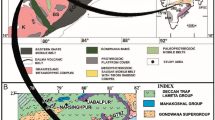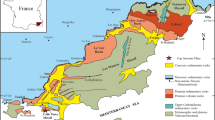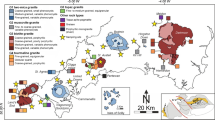Abstract
The results of long-term studies of the heavy mineral composition in Neopleistocene basal moraines, carried out according to a unified technique in numerous outcrops in the European Russian Subarctic, are summarized. The heavy fraction of moraines was formed due to the transport of material from three different glacial feeding provinces: distal, transit, and proximal. With the activation of glacier dynamics and increase in the exaration activity of the mainland ice, local features of the underlying rocks had a decisive influence on the moraine composition. Taking into account other lithological data, the established age and spatial tendencies of regular variability in the mineral composition of different-age moraine horizons made it possible to identify reliably their stratigraphic position.






Similar content being viewed by others
REFERENCES
Andreicheva, L.N., Osnovnye moreny evropeiskogo severo-vostoka Rossii i ikh litostratigraficheskoe znachenie (Basal Moraines in the European Northeastern Part of Russia and Their Lithostratigraphic Significance), St. Petersburg: Nauka, 1992.
Andreicheva, L.N., Provenances and their influence on the moraine composition in the Timan–Pechora–Vychegda region, Litol. Polezn. Iskop., 1994, no. 1, pp. 127–131.
Andreicheva, L.N., Pleistotsen evropeiskogo Severo-Vostoka (Pleistocene in the European Northeast), Yekaterinburg: UrO RAN, 2002.
Andreicheva, L.N. and Buravskaya, M.N., Typomorphic features of garnets from Middle Neopleistocene tills in the northern and southern parts of the Timan–Pechora–Vychegda region, Vestn. IG, 2017, no. 1, pp. 16–21.
Andreicheva, L.N. and Buravskaya, M.N., Typomorphic features of garnets and zircons in Middle Neopleistocene moraines in the northern and southern parts of the Timan–Pechora–Vychegda region, Lithol. Miner. Resour., 2021, no. 3, pp. 266–277.
Andreicheva, L.N. and Marchenko-Vagapova, T.I., The Neopleistocene of North European Russia: Stratigraphy, paleogeography, and paleoclimate, Stratigr. Geol. Correl., 2007, vol. 15, no. 4, pp. 421–436.
Andreicheva, L.N. and Nikitenko, I.P., Mineral composition of melkozem in basal moraines of the Timan–Pechora–Vychegda region, in Mineralogiya Timansko-Severoural’skogo regiona (Mineralogy of the Timan–North Ural Region), Makeev, A.B. and Ostashchenko, B.A., Eds., Syktyvkar: Komi Nauchn. Tsentr UrO AN SSSR, 1989, pp. 52–62.
Baturin, V.P., Petrograficheskii analiz geologicheskogo proshlogo po terrigennym komponentam (Petrographic Analysis of the Geological Past Based on Terrigenous Components), Moscow: AN SSSR, 1947.
Chalyshev, V.I. and Varyukhina, L.M., Biostratigrafiya verkhnei permi severo-vostoka evropeiskoi chasti SSSR (Biostratigraphy of the Upper Permian in the Northeastern European Part of the Soviet Union), Leningrad: Nauka, 1968.
Fishman, M.V., Yushkin, N.P., Goldin, B.A., and Kalinin, E.P., Mineralogiya, tipomorfizm i genezis aktsessornykh mineralov izverzhennykh porod severa Urala i Timana (Mineralogy, Typomorphism, and Genesis of Accessory Minerals from Igneous Rocks in the North Ural and Timan Regions), Leningrad: Nauka, 1968.
Gerasimov, E.M., Dolivo-Dobrovol’skaya, E.M., Kamentsev, I.E., et al., Rukovodstvo po rentgenovskomu issledovaniyu mineralov (A Guide to the X-Ray Study of Minerals), Frank, V.A., Ed., Leningrad: Nedra, 1977.
Ievlev, A.A., History of the study of silver mines during the reign of Ivan III, Vopr. Istor. Estestvozn. Tekhn., 2014, no. 1, pp. 50–68.
Kochetkov, O.S., Aktsessornye mineraly v drevnikh tolshchakh Timana i Kanina (Accessory Minerals in Ancient Sequences in the Timan and Kanin Regions), Leningrad: Nauka, 1967.
Kravets, V.S., Mesozoic deposits: The Jurassic, in Geologiya i perspektivy neftegazonosnosti severnoi chasti Timano-Pechorskoi oblasti (Geology and Perspectives of Oil-and-Gas Potential in the Northern Timan–Pechora Region), Dedeev, V.A., Ed., Leningrad: Nedra, 1966, pp. 43–62.
Kuznetsova, L.A., Pleistotsen Pechorskogo Priural’ya (Pleistocene in the Pechora Area of the Cis-Ural Region), Kazan: Kazan. Univ., 1971.
Ryabchenkov, A.S., Regional principles and aspects for studying the boulder and mineral composition of Quaternary deposits in the northeastern Russian Platform, in Sbornik statei po geologii i gidrogeologii (Collection of Papers Devoted to Geology and Hydrogeology), Chapovskii, E.G., Ed., Moscow: Nedra, 1965, no. 4, pp. 173–194.
Vishnyakov, S.G., Source zone for the clastic material in Paleozoic deposits at the northwestern margin of the Moscow region syneclise, Tr. Voronezh. Gos. Univ., 1958, vol. 48, pp. 15–27.
Funding
This work was accomplished under the State Task, NIR GR no. AAAA-A17-117121140081-7.
Author information
Authors and Affiliations
Corresponding author
Additional information
Translated by D. Sakya
Rights and permissions
About this article
Cite this article
Andreicheva, L.N. Formation of the Mineral Composition of Neopleistocene Basal Moraines in the European Russian Subarctic. Lithol Miner Resour 57, 348–362 (2022). https://doi.org/10.1134/S0024490222030026
Received:
Revised:
Accepted:
Published:
Issue Date:
DOI: https://doi.org/10.1134/S0024490222030026




